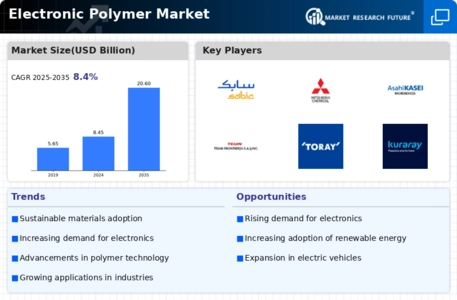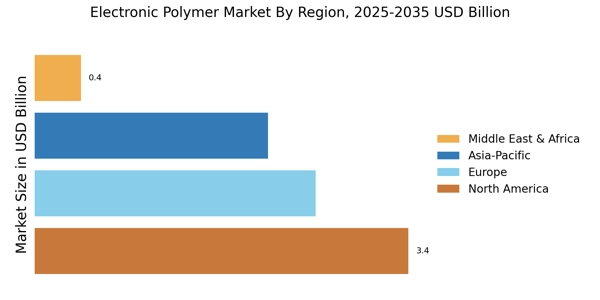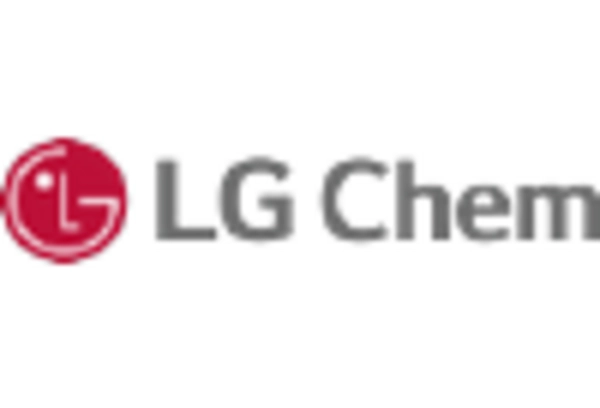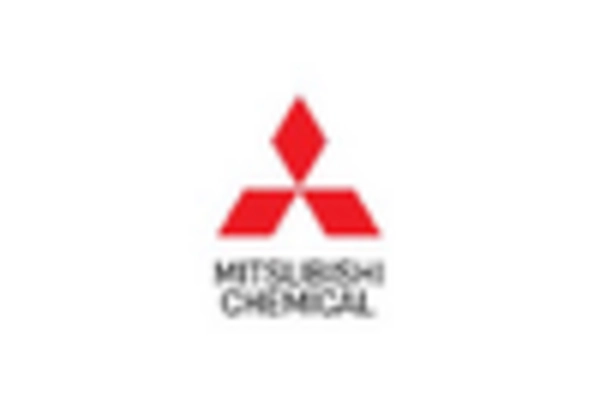Rising Demand for Lightweight Materials
The Electronic Polymer Market is experiencing a notable increase in demand for lightweight materials, particularly in the automotive and aerospace sectors. As manufacturers seek to enhance fuel efficiency and reduce emissions, the adoption of electronic polymers is becoming more prevalent. These materials offer a combination of strength and reduced weight, which is essential for modern engineering applications. In 2025, the market for lightweight materials is projected to reach approximately 200 billion USD, with electronic polymers playing a crucial role in this growth. This trend indicates a shift towards more sustainable manufacturing practices, as companies aim to meet regulatory standards and consumer expectations for environmentally friendly products. Consequently, the Electronic Polymer Market is likely to benefit from this rising demand, as it aligns with broader industry goals of innovation and sustainability.
Expansion of Consumer Electronics Market
The expansion of the consumer electronics market is significantly impacting the Electronic Polymer Market. With the increasing demand for smartphones, tablets, and other electronic devices, the need for high-performance materials is more pronounced than ever. Electronic polymers are essential in the production of components such as circuit boards, connectors, and displays, which are integral to modern consumer electronics. The consumer electronics market is projected to reach approximately 1 trillion USD by 2026, indicating a robust growth trajectory. This expansion is likely to drive demand for electronic polymers, as manufacturers seek materials that enhance device performance while reducing costs. As a result, the Electronic Polymer Market is expected to thrive in this environment, capitalizing on the growing consumer appetite for innovative electronic products.
Technological Advancements in Electronics
Technological advancements in electronics are significantly influencing the Electronic Polymer Market. The proliferation of smart devices, wearables, and IoT applications necessitates the development of advanced materials that can meet the demands of high-performance electronics. Electronic polymers are increasingly utilized in flexible displays, sensors, and conductive inks, which are essential for modern electronic applications. The market for flexible electronics is expected to grow at a compound annual growth rate of over 20% from 2025 to 2030, indicating a robust opportunity for electronic polymers. This growth is driven by the need for innovative solutions that enhance device functionality while maintaining lightweight and flexible characteristics. As a result, the Electronic Polymer Market is poised to expand in tandem with these technological advancements, providing essential materials for the next generation of electronic devices.
Growing Focus on Renewable Energy Solutions
The Electronic Polymer Market is witnessing a growing focus on renewable energy solutions, particularly in the development of solar cells and energy storage systems. Electronic polymers are increasingly being integrated into photovoltaic cells and batteries, enhancing their efficiency and performance. The renewable energy sector is projected to reach a market size of over 1 trillion USD by 2030, with electronic polymers playing a pivotal role in this transformation. As countries strive to reduce their carbon footprints and transition to sustainable energy sources, the demand for efficient materials in energy applications is likely to surge. This trend not only supports the growth of the Electronic Polymer Market but also aligns with global efforts to combat climate change and promote sustainable development.
Increased Investment in Research and Development
Increased investment in research and development is a key driver for the Electronic Polymer Market. As industries recognize the potential of electronic polymers in various applications, funding for innovative research is on the rise. This investment is crucial for developing new materials with enhanced properties, such as improved conductivity, flexibility, and thermal stability. In 2025, R&D spending in the materials science sector is expected to exceed 100 billion USD, with a significant portion allocated to electronic polymers. This influx of funding is likely to accelerate the pace of innovation, leading to the introduction of advanced electronic polymer products that meet the evolving needs of various industries. Consequently, the Electronic Polymer Market stands to benefit from these advancements, as new applications and technologies emerge.


















Leave a Comment